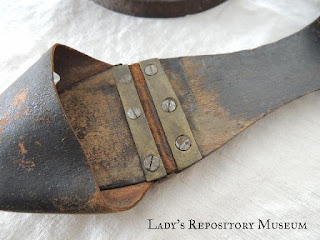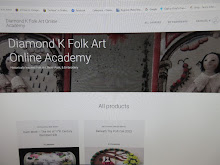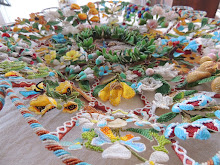For those muddy, Spring Dayes.....
I was going through the storage repacking this morning, and pulled some fun things to share that I don't think I have ever put on the blog before. Most folks know I have a '
thing' for early shoes, especially children's shoes....but even moreso, I am absolutely fascinated by overshoes. I pulled a few above so they could be seen together, and in looking at them as a group their differences can be admired. Before rubber overshoes were made in the mid 19th c, there were a number of shoes available to help protect ones 'good' shoes from mud of the countryside and filth of paved city streets. As times changed, and shoes changed shape, so did the overshoes that were meant to protect them. I use the term overshoes sloppily~ technically, there are three terms used to describe protective footwear~ 1. Pattens. These are made of wood, usually Alder for its ability to resist rot. The wood sole is raised up off the ground by a hand forged iron ring...now even then, the term ring is a bit generic, as the shape could be an oval, an hour glass shape, a funky scallop shape and I have even seen hearts. These had leather or cloth latchets or straps attached to the soles, that fit up over the shoe and tied, to keep the patten on the foot. The second term is 'Overshoe', which was a wood or cork flat sole, fit with either a toe or heel cap, or both, with the sole being hinged in one or two spots for more flexibility in walking. One would slip their foot into the toe cap, and there was usually a strap or tie round the ankle to hold them on the foot. The third type shoes were called Clogs, and usually were made together with the shoes they were worn with~ in matching pairs. Clogs soles were entirely of leather, with latchets that fit up over the shoe and tied to keep them on~ they sound alot like Pattens, but are quite different.

In this photo, one can see a child's wooden patten with its red morocco leather shoe behind an adult clog. As you can see, the clog sits flat to the floor~ there is no instep, and no iron ring underneath~ the entire sole of the clog makes contact with the floor.
Clogs were common the first half of the 18th c, and by the wide shape of the heel and pointy toe of this pair, I date them to 1740. Entirely hand stitched, they really are a wonder of the shoe makers art
Lady's shoe would have fit exactly into these, with no sloppy room to spare
A tiny bit of a heel, and minimal wear to the soles~ these were a wealthy womans clogs, and they probably never touched the actual dirt in their lives.
To date pattens, the shape of the sole is most easily used~ as they followed the shape of shoe soles closely~ the patten to the rear in this photo dates to the 1840s, with the overshoe to the front, c1820-30.
I have found hinged overshoes to be exceedingly rare, as the leather of the hinges would get dry rot and they would fall apart and get thrown out. Two brass strips are screwed down over a strip of leather, and in the day, could be changed out by removing the screws in the brass strips and replacing the leather strip. I have seen some overshoes with two hinged areas, mine just has this one.
To the heel, there is a polished brass heel cap, beneath of which the cloth strap is attached
This overshoe has its leather sole nailed on with iron nails, of which have discolored the leather around each one...they stick up a bit, and kind of feels like nonskid as one slides the hand across them...I cant help but think they were meant for a little added traction on a slippery ground.
Top photo
Back Row Left~Rt
908.2016.31 single hinged overshoe, c1820-30
723.2013.41 single iron heel patten , c1840
661.2012.35 pattens, pair, c1800-20
655.2012.29 pattens, pair, c1840
Front Row, Left~Rt
911.2016.34 clogs, pair, c1740
269.2004.22 red morocco leather child's shoes, 1780
271.2004.24 pattens, pair together with previous shoes, 1780
554.2011.24 single patten, doll size, c1740
481.2009.16 pattens, pair c1820

































